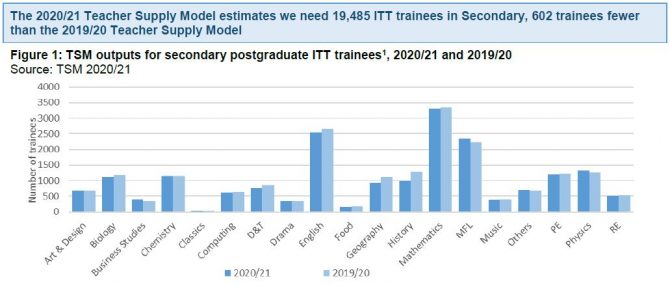More than 1,500 fewer primary trainee teachers and 602 fewer secondary trainees are needed to start courses in 2020-21, new government projections reveal.
The Teacher Supply Model (TSM) is used by the Department for Education to monitor recruitment to initial teacher training (ITT) courses.
Although the TSM estimates that 11.8 per cent fewer primary trainees (1,536) are needed to begin courses for 2020-21 and three per cent fewer secondary will be required, this is not uniform across all subject areas.
Five subjects have seen an increase in trainees, with the largest increase in business studies.
The largest falls in subject place numbers, as a percentage, were for history, geography and design and technology.
The document says that GCSE take-up for geography and history is now “in line” with the English Baccalaureate (EBacc) ambition of the DfE – 75 per cent take-up by 2024.
Therefore there is no longer a need to “over-recruit trainees for these subjects above baseline requirements”. “This has reduced ITT trainee requirements for both these subjects this year,” the document adds.
However, to meet the 75 per cent EBacc target, uptake in GCSE modern foreign languages “must increase”.

When estimating the number of postgraduate ITT trainees required, the TSM estimates the overall number of qualified teachers that “will be needed within state-funded schools in England in future based on projected pupil numbers, curriculum changes, and other factors”.
The TSM then estimates the number of new teachers needed to enter the profession each year, as well as whether they will be newly qualified, returners to the sector after a break or previously qualified but are new to the state sector.
The TSM then estimates how many trainees are needed to start postgraduate ITT courses in 2020-21 in order to provide the required number of NQTs in 2021-22.
Reasons for the fall in the number of primary and secondary ITT trainees required include an increase in the number of current undergraduate trainees, thereby reducing the need to recruit future postgraduate trainees.
The School Workforce Census methodology shows there was a higher number of entrants in previous years who were returners or new to the state sector than originally thought, according to the document.
This has led the TSM to assume that a “slightly greater proportion of teachers entering the stock in future years will be returners or new to the state-funded sector with a corresponding fall in the proportion that will be NQTs”, thereby slightly reducing ITT requirements.
For the first time, the TSM has accounted for NQTs entering service via the assessment only route. This reduces the requirement for postgraduate ITT trainees.







Your thoughts